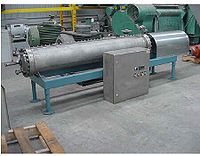Pin Mixers
Pin Mixers are pin-type solids processor designed for applications requiring high energy input to materials for mixing or micro-pelletizing. It is a high speed, conditioning and micro-pelletizing device that converts dust into small agglomerates through the action of a high speed rotor shaft and pin assembly and the addition of liquids such as water, binders, oil or surfactants.
Applications
The Pin Mixer is ideally suited for applications requiring extreme micro-pelletizing, mixing-conditioning with small pellet size control and preparation of a feed mixture for further processing in a pelletizer. Materials agglomerated in the Pin Mixer include: carbon black, cement kiln dust, pigments, coal dust, pesticides, electric furnace baghouse dust, limestone fines, graphite, coke, petroleum coke fines, bauxite and silica fume.
Construction and Processes
The Pin Mixer features a cylindrical, stationary shell with a length-to-diameter ratio of between four and five. Inside the shell is a replaceable rubber liner and a shaft with radially-extending rows of pins on a helix pattern. There is a close tolerance between the tips of the pins and the inside of the mixer shell.
Shaft rotational speed, and therefore tip speed, is high (several hundred RPM), which is higher than the speed of traditional paddle mixers, pugmills and Ampel conditioners.
The material enters at one end of the cylinder and is whipped by the pins as it moves from the inlet, through the shell and to the bottom outlet. As a fine spray of liquid is added at the entry section and distributed throughout the powder, fine mixing and micro-agglomeration will occur. The end result is a wetted, agglomerated and densified micro-pellet.
Advantages
- Aseptic aeration
- Emulsification
- Continuous mixing
- PLC standard in all aseptic systems
- Operator-friendly, smooth and trouble-free operation
- Pre-assembled and factory-tested
Video
